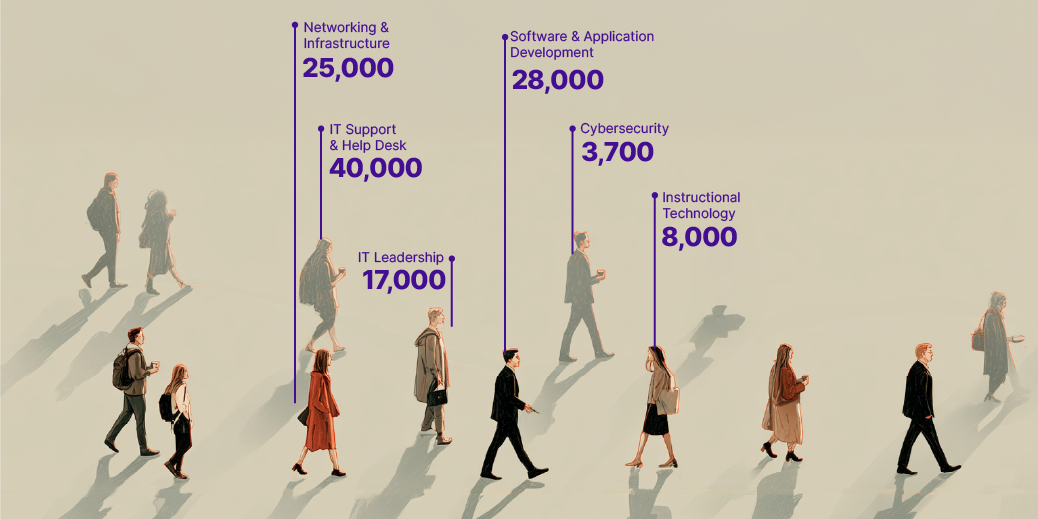

Higher education relies on more than brilliant faculty and curious students. Behind every virtual class, research server, LMS, or data dashboard is a small but essential workforce. And it’s smaller than you think.
Based on the most recently available federal labor data, EDUCAUSE surveys, and institutional benchmarks, this Essential Edition of The EdTech Mentor dives into the 150,000+ IT professionals quietly powering America’s colleges and universities. From one-person tech teams at small colleges to sprawling 300-person operations at R1 universities(what is an R1?), we map the real structure of campus IT: who they are, what they do, and why every EdTech marketer and founder should be paying attention.
Whether you’re selling to higher ed or designing tools for learning, understanding this workforce isn’t optional. It’s the key to connection, adoption, and long-term impact.

Out of more than 4 million people working in U.S. higher education, only about 150,000 are in IT roles. That’s just 3.7% of the total workforce. Yet this small group shoulders responsibility for digital infrastructure, classroom tech, cybersecurity, enterprise systems, and the day-to-day support that makes online and hybrid learning possible.
They are often overlooked. But for any EdTech company trying to win adoption, navigate integrations, or prove ROI, these are your front lines. They’re the ones installing your software, defending it to faculty, managing your RFPs, and troubleshooting on launch day.
Sources: - BLS - Occupational Employment Statistics for Colleges, Universities, and Professional Schools (NAICS 611310) - IPEDS Fall 2023 Employees in Postsecondary Institutions
Here’s what the breakdown looks like:
- IT Support & Help Desk (40,000): The largest group. They field tickets, staff computer labs, and often serve as the first impression of your product.
- Networking & Infrastructure (25,000): The people who make sure systems stay online, fast, and secure.
- Cybersecurity (3,700): The fastest-growing group, but still incredibly lean.
- Software & Application Development (28,000): Integrators, developers, and ERP specialists.
- Instructional Technology (8,000): The bridge between product and pedagogy.
- IT Leadership (17,000): CIOs, CTOs, and directors. Your strategic partners and budget gatekeepers.
Each role interacts with EdTech differently. Marketers who treat them all as one audience miss opportunities to tailor messaging to their unique challenges and values.
Sources: - BLS - Occupational Employment and Wage Statistics by Role - EDUCAUSE Workforce Studies

A small liberal arts college might have fewer than 10 full-time IT staff—meaning every person wears multiple hats. Mid-sized universities typically employ 20–70 IT staff. Large public and research universities? 300+ isn’t uncommon.
Understanding this context helps you adjust expectations, support models, and pricing. Selling a deeply technical solution to a campus with one IT generalist? That’s a red flag. Conversely, underestimating the complexity of a multi-campus R1 could sink your rollout.
Source: - Golden, D. (2006). Cultivating Careers: Professional Development for IT - EDUCAUSE Benchmarking Reports
Despite the growing threat landscape, only ~3,700 cybersecurity specialists work in U.S. higher ed. Many institutions have just one full-time security analyst—if any.
This isn’t just an IT issue; it’s a product risk. If your platform can’t meet their security requirements—or help lighten their burden—you’re not getting through procurement. Smart EdTech brands are now building marketing materials specifically for this audience.
Source: - BLS - Occupational Employment Statistics (OES) for Information Security Analysts (Standard Occupation Code 15-1212) within NAICS 611310, 611210
Roughly 75% of IT staff are centralized in main IT units; the rest are embedded in departments like business, health sciences, or arts.
This matters when navigating pilots, integrations, or contracts. Your champion may not sit in central IT—but they will need their buy-in. Messaging that acknowledges these dynamics builds trust and accelerates internal alignment.
Source: - EDUCAUSE Review - IT Centralization Patterns and CIO Reporting: An Update
In 2021, 42% of institutions said their IT organization had gotten smaller. At the same time, they’re being asked to support more platforms, more data, and more modalities than ever before.
What does this mean for you? Your product’s ease of implementation, quality of support, and alignment with institutional strategy now carry even more weight. In an environment of lean staffing, complexity kills deals.
Source: - EDUCAUSE - Smaller and Restructured: How the Pandemic Is Changing the Higher Education IT Workforce
These 150,000 professionals don’t just keep the lights on. They’re your best allies—or your biggest blockers. They’re stretched, strategic, and more essential than ever.
If you’re not marketing to them with empathy—that is, truly understanding their needs—you’re missing the very people who make your success possible.
Ready to connect with the people who make EdTech work? At 27zero, we help you understand, reach, and support campus IT decision-makers through strategic marketing that drives adoption and impact. Learn how we can help your EdTech brand grow.
Written by Laureano Diaz, Chief Strategy Officer at 27zero. This article is part of The EdTech Mentor: Essential Edition and was developed with AI-assisted research and editorial support.









